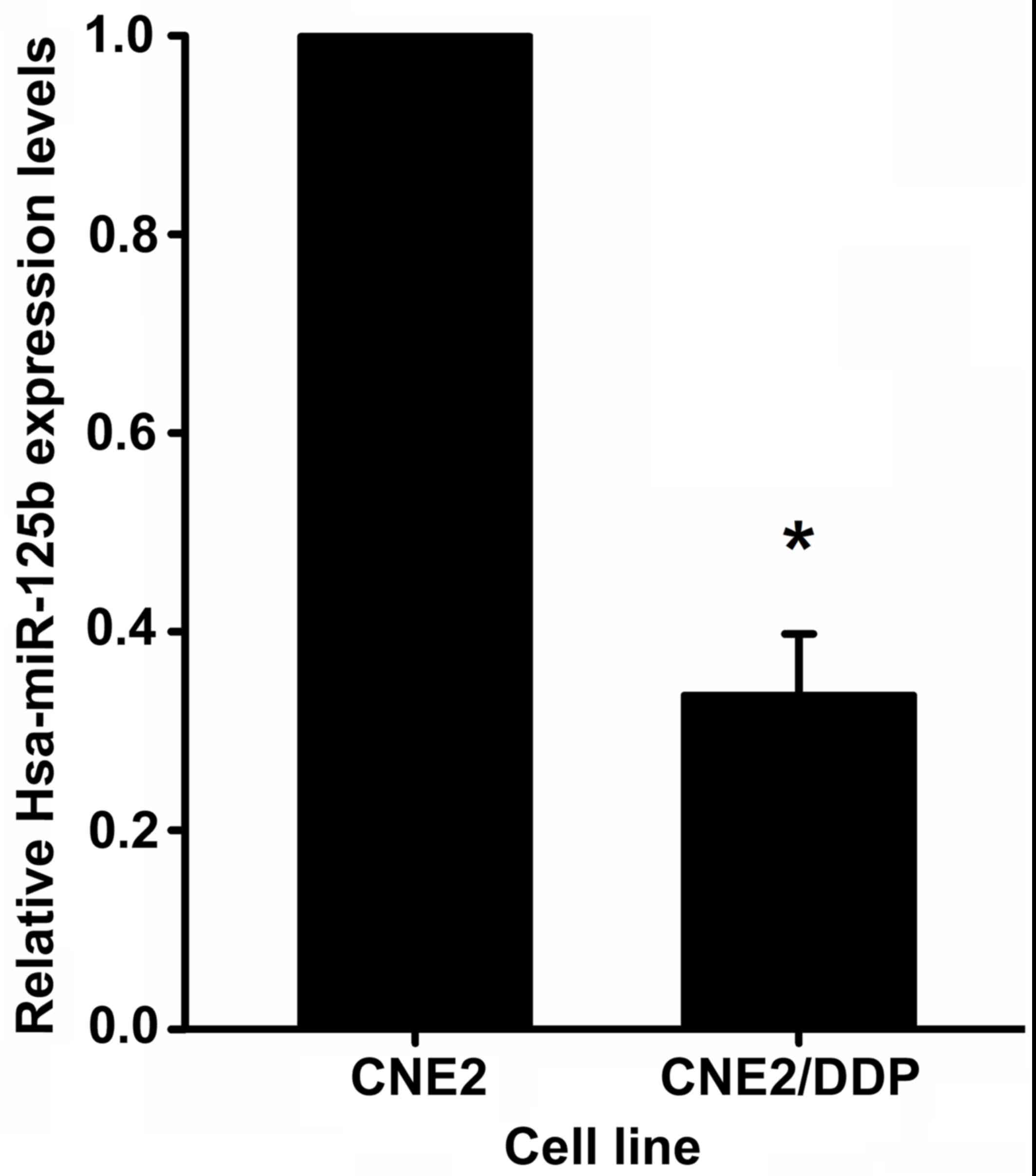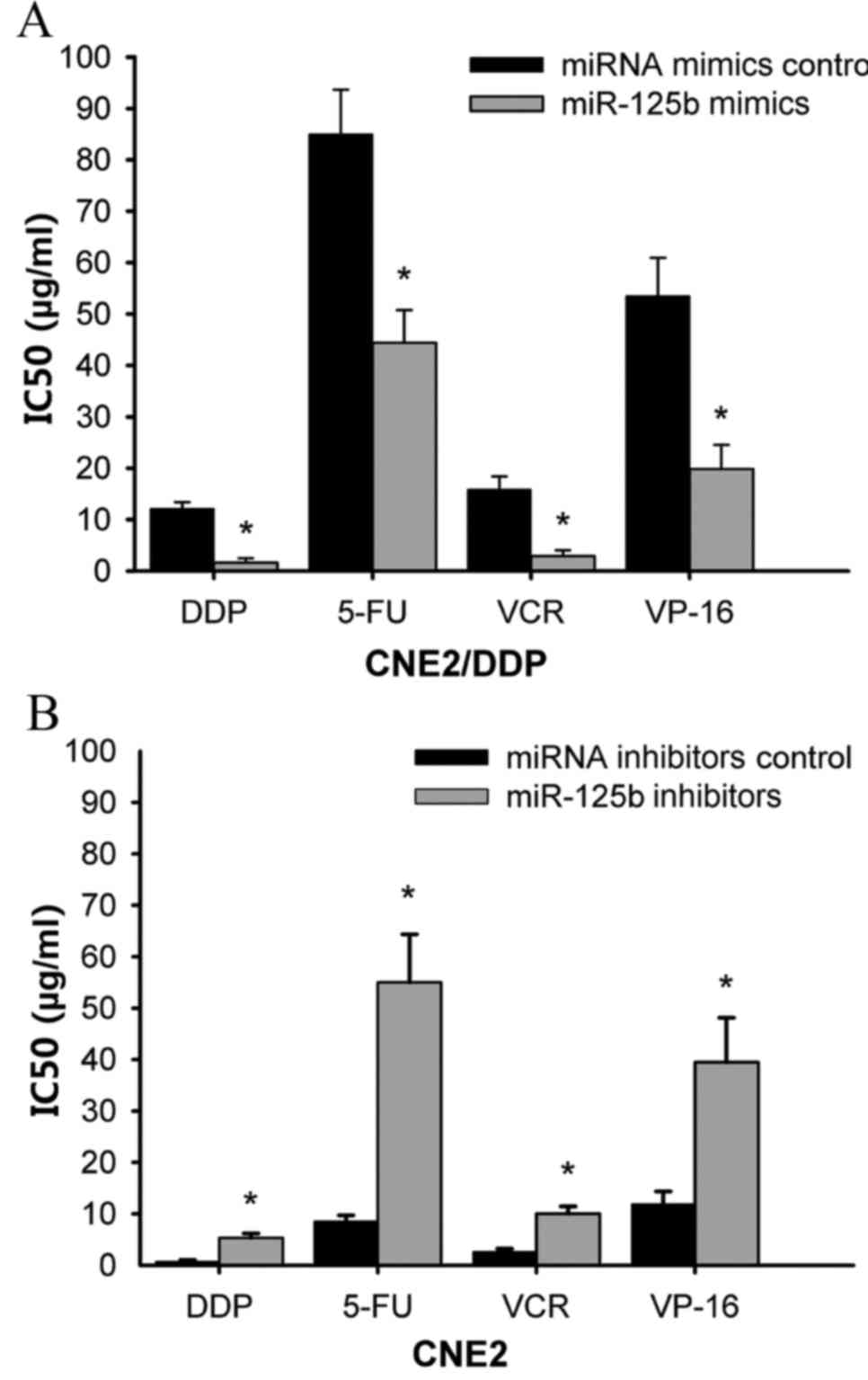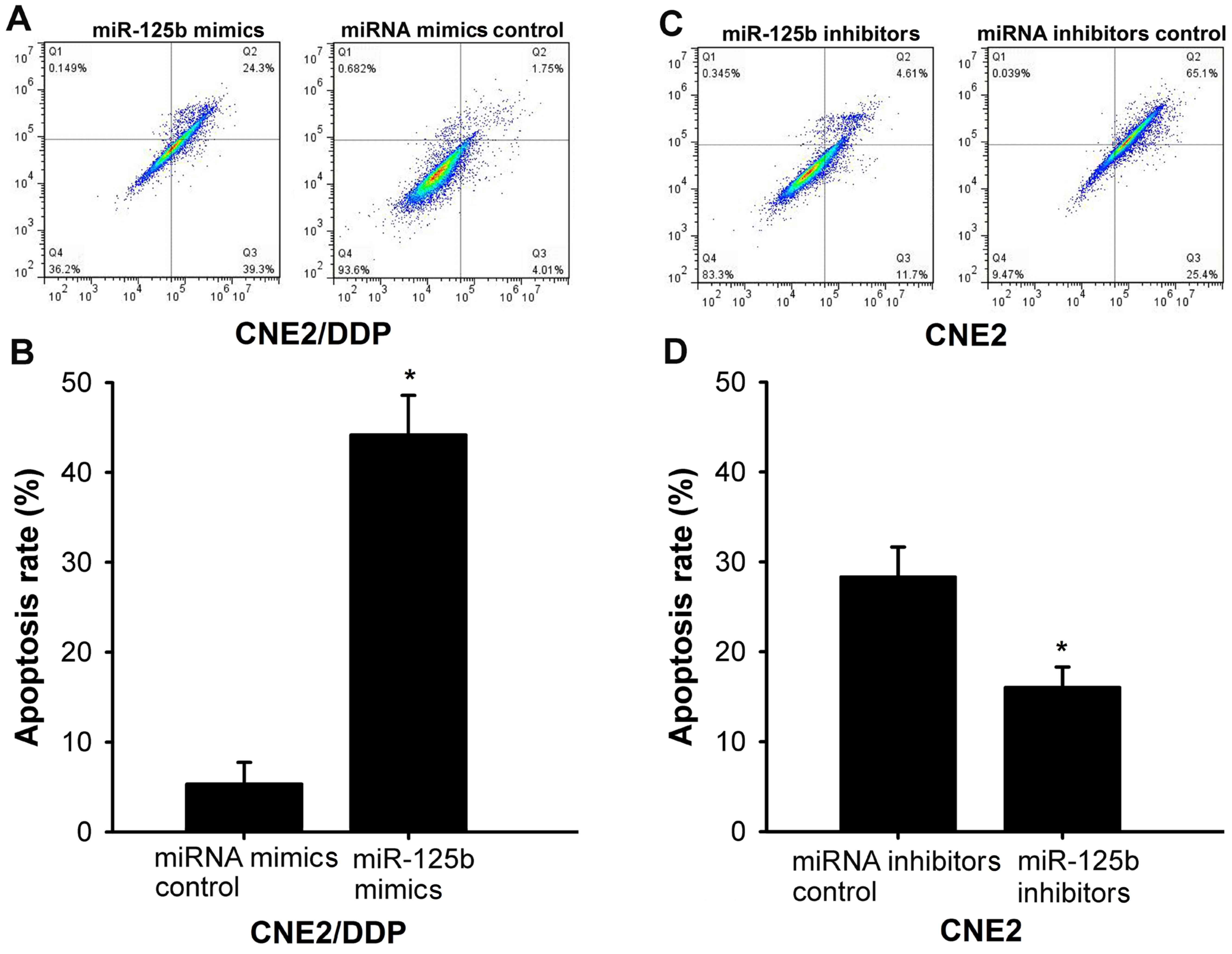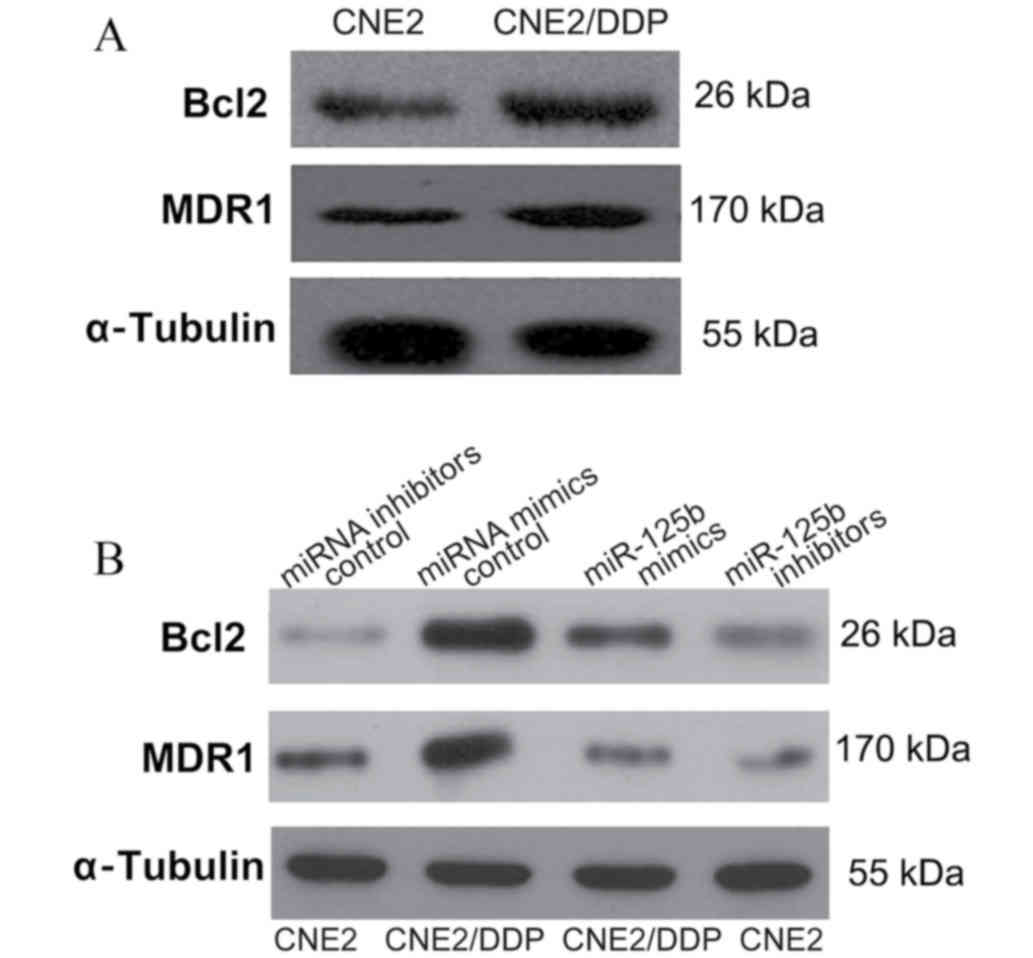microRNA-125b reverses the multidrug resistance of nasopharyngeal carcinoma cells via targeting of Bcl-2
- Authors:
- Published online on: February 22, 2017 https://doi.org/10.3892/mmr.2017.6233
- Pages: 2223-2228
Abstract
Introduction
Nasopharyngeal carcinoma (NPC) is a common head and neck malignancy in southern China, with >20,404 associated cases of mortality reported in 2012 (1–3). NPC is highly metastatic, as evidenced by the observation that 30–60% of patients diagnosed with local-advanced disease will develop distant metastases (4–6). Despite the majority of patients with metastatic NPC typically experiencing a good initial response to chemotherapy, frequent recurrences can occur due to the development of multidrug resistance (MDR) against chemotherapeutic agents (7). As a result, the prognosis for patients with metastatic NPC remains poor, with a 3-year overall survival rate of 30–40% (6,8), which emphasizes the requirement for novel therapies that target drug-resistant NPC.
MicroRNAs (miRNA) are small non-coding nucleotides that regulate the expression of target genes at a post-transcriptional level. miRNAs reportedly affect tumorigenesis (9) and NPC prognosis by functioning as oncogenes (10,11) or tumor suppressor genes (12,13). Indeed, the role of miRNAs in MDR has recently received considerable attention, as previous reports have suggested that miRNAs may regulate tumor cell responses to chemotherapy, and the manipulation of miRNAs may modulate MDR (14–16).
There is accumulating interest in understanding the role of miR-125b in cancer. miR-125b was one of the first miRNAs identified, and studies have demonstrated that miR-125b serves a functional role in MDR, tumorigenesis and in the prognosis of different cancer types (17–19). Consistent with these reports, the upregulation of miR-125b in Taxol-resistant cells, inhibited Taxol-induced cytotoxicity and apoptosis, and promoted a subsequent increase in Taxol resistance in breast cancer cells (20). However, the effects of miR-125b in the development of MDR in NPC remain elusive.
The aims of the present study were to characterize miR-125b expression levels in the cisplatin (DDP)-resistant CNE2/DDP human NPC cell line compared with the drug-sensitive parental CNE2 cell line, and to investigate the role of miR-125b in the development of MDR in NPC.
Materials and methods
Cell lines and culture conditions
The human NPC cell line CNE2 was provided by Professor MuSheng Zeng (Sun Yat-sen University Cancer Center (Guangzhou, China). CNE2 cells were cultured in Dulbecco's modified Eagle's medium supplemented with 10% fetal calf serum (Gibco; Thermo Fisher Scientific, Inc., Waltham, MA, USA) and maintained in a humidified incubator at 37°C and 5% CO2.
The DDP-resistant cell line CNE2/DDP was generated in our laboratory (Guangzhou, China) by supplementing culture medium with increasing concentrations of 0.5–10.0 µg/ml DDP (Mayne Pharma, Salisbury South, SA, Australia) over the course of 12 months until a significant increase in DDP-resistance was achieved compared with the CNE2 parental cell line. CNE2/DDP cells were cultured in the presence of DDP (0.5 µg/ml) to maintain the DDP-resistant phenotype, however, cells were cultured in drug-free medium for a minimum of 2 weeks prior to downstream experiments.
miRNA transfection
CNE2 and CNE2/DDP cells were seeded in 6-well plates at a density of 5×105 cells/plate 1 day prior to transfection. CNE2 cells were transfected with 100 nM miR-125b inhibitors or control miRNA inhibitors, and CNE2/DDP cells were transfected with 10 nM miR-125b mimics or 10 nM control miRNA mimics using HiPerfect Transfection Reagent (Qiagen, Inc., Valencia, CA, USA). Cells were harvested for downstream, analysis 48 h following transfection. miR-125b mimics, inhibitors and controls were purchased from Shanghai GenePharma Co., Ltd., (Shanghai, China).
Reverse transcription-quantitative polymerase chain reaction (RT-qPCR) for analysis of miRNA expression levels
Total RNA was isolated from cells using the TRIzol reagent (Invitrogen; Thermo Fisher Scientific, Inc., Carlsbad, CA, USA) according to the manufacturer's instructions. miRNA was purified using a mirVana™ miRNA Isolation kit (Ambion; Thermo Fisher Scientific, Inc., Foster City, CA, USA). RNA sample concentrations and purities were determined spectroscopically. RT-qPCR was performed using the GoTaq® qPCR Master Mix (Promega Corporation, Madison, WI, USA) and the MiniOpticon™ Real-Time PCR detection instrument (Bio-Rad Laboratories, Inc., Hercules, CA, USA) in addition to the SYBR-Green detection protocol (Invitrogen; Thermo Fisher Scientific, Inc.) in accordance with the manufacturer's instructions. Sequence-specific primers for miR-125b and hsa-U6 small nuclear RNA gene transcripts are listed in Table I. All PCR reactions were run in triplicate, and non-template controls were included. miRNA-125b expression levels in CNE2/DDP cells were calculated relative to control CNE2 cells using the 2-ΔΔCq method where ΔCq = CqmiRNA-125b - CqU6, and ΔΔCq = ΔCqCNE2/DDP - ΔCqCNE2.
Cell proliferation assay
At 48 h following transfection, cells were seeded onto 96-well plates (2×103 cells/well) and allowed to adhere to the culture vessel surface overnight. The following day, newly prepared DDP (Mayne Pharma), 5-fluorouracil (5-FU) (Shanghai Xudong Haipu Pharmaceutical Co., Ltd., Shanghai, China), vincristine (VCR) (Zhejiang Hisun Chemical Co., Ltd., Zhejiang, China) and etoposide (VP-16) (Jiangsu Hengrui Medicine Co., Ltd., Jiangsu, China) were added at final concentrations of 0.001-, 0.01-, 0.1-, 1-, 10- and 100-fold higher than the human peak plasma concentrations for each drug. Following 70 h, cell viability was assessed using a 3-(4,5-dimethyl-2-yl)-5-(3-carboxymethoxy-phenyl)-2-4-sulfophenyl)-2H-tetrazolium assay (Promega Corporation) according to the manufacturer's instructions. For each well, the absorbance was read at 490 nm using a spectrophotometer. The concentration at which each drug produced a 50% inhibition of cell growth (IC50) was estimated by constructing a relative survival curve. Experiments were performed in triplicate.
Apoptosis assay
Cells were seeded on 6-well plates (5×105/well), transfected as described previously and exposed to DDP (0.8 µg/ml) at 48 h following transfection. Apoptosis was then detected using a flow cytometry-directed annexin V-fluorescein isothiocyanate (FITC)/propidium iodide (PI) assay (KayGen Biotechnology, Co., Ltd., Nanjing, China) according to the manufacturer's instructions. Apoptotic cells were considered to be positive if they were annexin V-FITC-positive-PI-negative. Cells stained with annexin V-FITC or PI alone were used as controls.
Western blot analysis
Transfected cells were harvested and homogenized using Cell Lysis Buffer (Abcam, Cambridge, MA, USA). Then, 50 µg total protein was separated using 10% SDS-PAGE followed by transfer to nitrocellulose membranes. Membranes were blocked using 5% non-fat dry milk in Tris-buffered saline (TBS) for 1 h at 37°C and then incubated overnight at 4°C with B-cell CLL/lymphoma 2 (Bcl-2; 1:500; cat. no. 2872), ATP binding cassette subfamily B member 1 (MDR1; 1:200; cat. no. 13978) and α-tubulin (1:1,000; cat. no. 2144) primary antibodies purchased from Cell Signaling Technology, Inc. (Danvers, MA, USA). The following day, membranes were washed three times with 1X TBS-Tween 20 (TBST) and probed with horseradish peroxidase-conjugated goat anti-rabbit IgG antibodies (cat. no. sc-2301; 1:2,000; Santa Cruz Biotechnology, Inc., Dallas, TX, USA) for 1 h at room temperature. Membranes were then washed with 1X TBST, and protein bands were visualized using an enhanced chemiluminescence assay according to the manufacturer's instructions (GE Healthcare Bio-Sciences, Pittsburgh, PA, USA).
Statistical analysis
All experiments were conducted in triplicate, and the data are presented as the mean ± standard deviation. Differences between means were analyzed using the Student's t-test. All statistical analyses were performed using SPSS 13.0 software (SPSS, Inc., Chicago, IL, USA). All statistical tests were two-sided, and P<0.05 was considered to indicate a statistically significant difference.
Results
miR-125b is differentially expressed in MDR NPC cell lines
In order to investigate whether miR-125b is involved in the MDR of NPC cells, miR-125b expression levels in the MDR NPC cell line (CNE2/DDP) and the parental CNE2 cell line were determined using RT-qPCR analysis. As demonstrated in Fig. 1, miR-125b expression was observed to be significantly downregulated (3.04±0.59-fold, P=0.017) in CNE2/DDP cells compared with CNE2 cells.
miR-125b modulates MDR in NPC cells
To investigate an association between miR-125b and MDR in NPC cells, the expression levels of miR-125b in CNE2 and CNE2/DDP cells, which express relatively high and low levels of miR-125b respectively, were altered, and the effects of specific anticancer agents on the MDR phenotype were determined. As shown in Fig. 2A, transfection of CNE2/DDP cells with miR-125b mimics significantly increased the chemosensitivity of cells to DDP (IC50: 12.16±1.23 vs. 1.62±0.85 µg/ml, P=0.002), 5-FU (IC50: 85.00±8.67 vs. 44.40±6.40 µg/ml, P=0.025), VCR (IC50: 15.84±2.56 vs. 2.88±1.15 µg/ml, P=0.001) and VP-16 (IC50: 53.49±7.43 vs. 19.87±4.67 µg/ml, P=0.017) compared with cells transfected with miRNA mimic controls. By contrast, suppression of miR-125b expression in CNE2 cells by transfecting cells with miR-125b inhibitors, significantly decreased the sensitivity of cells to DDP (P=0.011), 5-FU (P=0.001), VCR (P=0.034) and VP-16 (P=0.010) treatment (Fig. 2B). Together, these results suggest that modulation of miR-125b expression affects MDR in NPC cells.
miR-125b sensitizes CNE2/DDP cells to DDP-induced apoptosis
To investigate the possibility that miR-125b upregulation increases DDP-induced apoptosis, CNE2/DDP cells were transfected with either miR-125b mimics or miRNA mimic controls and treated with 0.8 µg/ml DDP for 24 h. Transfection of CNE2/DDP cells with miR-125b mimics significantly increased the percentage of apoptotic cells, as determined using annexin-V staining, compared with cells transfected with miRNA mimic controls (P<0.001; Fig. 3A and B). Additionally, by transfecting CNE2 cells with an miR-125b inhibitor, repression of endogenous miR-125b significantly inhibited DDP-induced apoptosis compared with cells transfected with control miRNA inhibitors (P=0.006; Fig. 3C and D). Together, these results demonstrate that miR-125b serves an important role in modulating DDP resistance in NPC cells.
miR-125b regulates MDR by targeting Bcl-2 in NPC
A previous study demonstrated an association between MDR and the upregulation of antiapoptotic proteins, such as Bcl-2 (21). Taking the role of Bcl-2 in apoptosis and chemoresistance into account, the function of miR-125b in modulating MDR through regulating Bcl-2 expression was investigated in the present study. Consistent with this hypothesis, CNE2/DDP cells were found to display a marked increase in MDR1 and Bcl-2 expression levels compared with CNE2 cells (Fig. 4A). Furthermore, CNE2/DDP cells transfected with miR-125b mimics, notably inhibited Bcl-2 and MDR1 protein expression levels compared with cells transfected with control miRNA mimics (Fig. 4B). Consistent with these findings, CNE2 cells transfected with miR-125b inhibitors exhibited notably increased Bcl-2 expression levels (Fig. 4B). Together, these results demonstrate that miR-125b regulates NPC resistance to DDP, in part, by targeting Bcl-2 protein expression levels.
Discussion
In the present study, the role of miR-125b in the development of MDR in NPC cells was investigated. Using RT-qPCR analysis, miR-125b was demonstrated to be significantly downregulated in MDR CNE2/DDP cells compared with chemosensitive CNE2 counterparts. Transfection of CNE2/DDP cells with miR-125b mimics was also observed to increase apoptosis and the chemosensitivity of cells, in part, through downregulating Bcl-2 and MDR1 protein expression levels. These results suggest that miR-125b may represent a novel therapeutic target to resensitize MDR NPCs to chemotherapy.
MDR is a major obstacle in the treatment of cancer patients with chemotherapy and is often associated with an increased efflux of drugs due to some proteins such as P-glycoprotein (P-gp) and multidrug resistance-associated protein 1 (MRP1), which belong to the ATP-binding cassette transporters (22). The involvement of P-gp and MRP1 in MDR is due to their overexpression in resistant tumor cells. In particular, P-gp functions as a ‘protein scavenger’, which is able to ‘capture’ drugs and transport them out of cells (23). The putative role of miRNAs in human cancers has become a focus of current research, with specific reports indicating an association between miRNAs and MDR development (24). miR-125b is a member of the miR-125b family, which is located on chromosomes 11q24.1 (miR-125b-1) and 21q21 (miR-125b-2). miR-125b upregulation has been reported in certain cancer types including colorectal (25), non-small-cell lung (26) and head and neck cancers (27). However, a tumor suppressive role of miR-125b has also been reported in specific tumor types that display reduced miR-125b expression levels (28,29). Notably, previous studies have observed altered (increased and decreased) miR-125b expression levels in various drug-resistant cancer cells. Chen et al (30) demonstrated that miR-125b was upregulated in temozolomide-resistant glioblastoma stem cells, and miR-125b inhibition resulted in a significant increase in temozolomide-induced cytotoxicity, apoptosis and enhanced temozolomide sensitivity. By contrast, doxorubicin-resistant MCF-7 (MCF-7/DR) cells reportedly exhibit significantly lower levels of miR-125b expression compared with parental MCF-7 cells (31), which is consistent with the results observed in the present study demonstrating that miR-125b was significantly downregulated in CNE2/DDP cells compared with CNE2 cells.
Despite the reported association between miR-125b and poor prognosis (23,24), few reports have investigated the specific role of miR-125b in the regulation of drug resistance. For example, miR-125b overexpression in breast cancer correlates with an increase in tumor stem cell properties, such as chemoresistance, whereas knockdown of miR-125b is associated with a decrease in tumor stem cell-like populations (32). In OV2008 ovarian cancer cells, miRNA-125b upregulation has been observed to suppress DDP-induced cytotoxicity and apoptosis, and increase DDP resistance (33). In the present study, the role of miR-125b in regulating the drug resistance of CNE2/DDP cells was evaluated. miRNA-125b upregulation was observed to promote a significant increase in cell cytotoxicity and apoptosis. This is consistent with the findings presented by Xie et al (31) demonstrating that transfection of miR-125b significantly increases the cytotoxicity of doxorubicin in MCF-7/DR cells. Collectively, these results suggest that miR-125b serves a functional role in modulating chemotherapy resistance in cancer cells.
The mitochondrial pathway of apoptosis reportedly serves an important role in chemotherapy-induced apoptosis, and Bcl-2 is recognized as a critical regulator of this pathway (34). Results of the present study demonstrated that transfection of CNE2/DDP cells with miR-125b mimics increased DDP-induced apoptosis. To elucidate the mechanisms by which miR-125b modulates MDR in NPC cells, the role of miR-125b in regulating Bcl-2 protein expression levels was then investigated. The results suggest that miR-125b modulates the susceptibility of NPC cells to DDP-induced apoptosis by regulating Bcl-2 and MDR1 expression directly, which provides an explanation for the observed differences in the sensitivity of NPC cells to VCR, 5-FU, VP-16 and DDP chemotherapeutic agents.
The primary focus of the present study was MDR, which is a frequent occurrence in patients with cancer that are treated with chemotherapy, and represents an obstacle to successful treatment. Therefore, the targeting of MDR-promoting miRNAs, such as miR-125b, may represent an improved treatment strategy for patients with cancer compared with therapeutic agents that target a single protein. However, it is important to note that the results of the present study were limited to an in vitro setting, which lacks important cues from the in vivo tumor microenvironment and should not be considered as an accurate representation of clinical tumors. Therefore, future studies that aim to assess the functional role of miRNA-125b in NPC MDR should be conducted using in vivo methods and in a clinical setting.
In summary, the present study investigated the role of miRNAs in the development of MDR in NPC cells. miR-125b was observed to modulate the sensitivity of NPC cells to specific anticancer agents by regulating Bcl-2 expression. Together, these results provide a novel insight into the mechanisms of MDR in NPC, and provide a rationale for the development of clinical strategies to manipulate miRNA expression to reverse MDR in human cancer.
Acknowledgements
The present study was supported by grants from the Health Department of Guangdong Province (grant no. B2013185) and the special fund of Cancer Center of Guangzhou Medical University (grant no. 2011-yz-09). Our laboratory is supported by FOCUSBIO (Focusbio, Inc., Guangzhou, China).
References
|
Wei KR, Zheng RS, Zhang SW, Liang ZH, Ou ZX and Chen WQ: Nasopharyngeal carcinoma incidence and mortality in China in 2010. Chin J Cancer. 33:381–387. 2014.PubMed/NCBI | |
|
Liu Q, Chen JO, Huang QH and Li YH: Trends in the survival of patients with nasopharyngeal carcinoma between 1976 and 2005 in Sihui, China: A population-based study. Chin J Cancer. 32:325–333. 2013. View Article : Google Scholar : PubMed/NCBI | |
|
International Agency for Research on Cancer, World Health Organization, . GLOBOCAN 2012: Estimated cancer incidence, mortality and prevalence worldwide in 2012. http://globocan.iarc.fr/Default.aspxJuly 1–2015. | |
|
Sun X, Su S, Chen C, Han F, Zhao C, Xiao W, Deng X, Huang S, Lin C and Lu T: Long-term outcomes of intensity-modulated radiotherapy for 868 patients with nasopharyngeal carcinoma: An analysis of survival and treatment toxicities. Radiother Oncol. 110:398–403. 2014. View Article : Google Scholar : PubMed/NCBI | |
|
Xiao WW, Huang SM, Han F, Wu SX, Lu LX, Lin CG, Deng XW, Lu TX, Cui NJ and Zhao C: Local control, survival, and late toxicities of locally advanced nasopharyngeal carcinoma treated by simultaneous modulated accelerated radiotherapy combined with cisplatin concurrent chemotherapy: Long-term results of a phase 2 study. Cancer. 117:1874–1883. 2011. View Article : Google Scholar : PubMed/NCBI | |
|
Jiang R, Cai XY, Yang ZH, Yan Y, Zou X, Guo L, Sun R, Luo DH, Chen QY, Huang PY, et al: Elevated peripheral blood lymphocyte-to- monocyte ratio predicts a favorable prognosis in the patients with metastatic nasopharyngeal carcinoma. Chin J Cancer. 34:237–246. 2015. View Article : Google Scholar : PubMed/NCBI | |
|
Meijerman I, Beijnen JH and Schellens JH: Combined action and regulation of phase II enzymes and multidrug resistance proteins in multidrug resistance in cancer. Cancer Treat Rev. 34:505–520. 2008. View Article : Google Scholar : PubMed/NCBI | |
|
Li JX, Huang SM, Wen BX and Lu TX: Prognostic factors on overall survival of newly diagnosed metastatic nasopharyngeal carcinoma. Asian Pac J Cancer Prev. 15:3169–3173. 2014. View Article : Google Scholar : PubMed/NCBI | |
|
Lu J, He ML, Wang L, Chen Y, Liu X, Dong Q, Chen YC, Peng Y, Yao KT, Kung HF and Li XP: MiR-26a inhibits cell growth and tumorigenesis of nasopharyngeal carcinoma through repression of EZH2. Cancer Res. 71:225–233. 2011. View Article : Google Scholar : PubMed/NCBI | |
|
Zhang LY, Ho-Fun Lee V, Wong AM, Kwong DL, Zhu YH, Dong SS, Kong KL, Chen J, Tsao SW, Guan XY and Fu L: MicroRNA-144 promotes cell proliferation, migration and invasion in nasopharyngeal carcinoma through repression of PTEN. Carcinogenesis. 34:454–463. 2013. View Article : Google Scholar : PubMed/NCBI | |
|
Luo Z, Dai Y, Zhang L, Jiang C, Li Z, Yang J, McCarthy JB, She X, Zhang W, Ma J, et al: miR-18a promotes malignant progression by impairing microRNA biogenesis in nasopharyngeal carcinoma. Carcinogenesis. 34:415–425. 2013. View Article : Google Scholar : PubMed/NCBI | |
|
Lu J, Luo H, Liu X, Peng Y, Zhang B, Wang L, Xu X, Peng X, Li G, Tian W, et al: miR-9 targets CXCR4 and functions as a potential tumor suppressor in nasopharyngeal carcinoma. Carcinogenesis. 35:554–563. 2014. View Article : Google Scholar : PubMed/NCBI | |
|
Ma L, Deng X, Wu M, Zhang G and Huang J: Down-regulation of miRNA-204 by LMP-1 enhances CDC42 activity and facilitates invasion of EBV-associated nasopharyngeal carcinoma cells. FEBS Lett. 588:1562–1570. 2014. View Article : Google Scholar : PubMed/NCBI | |
|
Yin W, Wang P, Wang X, Song W, Cui X, Yu H and Zhu W: Identification of microRNAs and mRNAs associated with multidrug resistance of human laryngeal cancer hep-2 cells. Braz J Med Biol Res. 46:546–554. 2013. View Article : Google Scholar : PubMed/NCBI | |
|
Hong L, Yang Z, Ma J and Fan D: Function of miRNA in controlling drug resistance of human cancers. Curr Drug Targets. 14:1118–1127. 2013. View Article : Google Scholar : PubMed/NCBI | |
|
Dai Y, Xie CH, Neis JP, Fan CY, Vural E and Spring PM: MicroRNA expression profiles of head and neck squamous cell carcinoma with docetaxel-induced multidrug resistance. Head Neck. 33:786–791. 2011. View Article : Google Scholar : PubMed/NCBI | |
|
Peng SC, Liao CT, Peng CH, Cheng AJ, Chen SJ, Huang CG, Hsieh WP and Yen TC: MicroRNAs MiR-218, MiR-125b and Let-7g predict prognosis in patients with oral cavity squamous cell carcinoma. PLoS One. 9:e1024032014. View Article : Google Scholar : PubMed/NCBI | |
|
Liu Z, Liu H, Desai S, Schmitt DC, Zhou M, Khong HT, Klos KS, McClellan S, Fodstad O and Tan M: miR-125b functions as a key mediator for snail-induced stem cell propagation and chemoresistance. J Biol Chem. 288:4334–4345. 2013. View Article : Google Scholar : PubMed/NCBI | |
|
Feliciano A, Castellvi J, Artero-Castro A, Leal JA, Romagosa C, Hernández-Losa J, Peg V, Fabra A, Vidal F, Kondoh H, et al: miR-125b acts as a tumor suppressor in breast tumorigenesis via its novel direct targets ENPEP CK2-α, CCNJ, and MEGF9. PLoS One. 8:e762472013. View Article : Google Scholar : PubMed/NCBI | |
|
Zhou M, Liu Z, Zhao Y, Ding Y, Liu H, Xi Y, Xiong W, Li G, Lu J, Fodstad O, et al: MicroRNA-125b confers the resistance of breast cancer cells to paclitaxel through suppression of pro-apoptotic Bcl-2 antagonist killer 1 (Bak1) expression. J Biol Chem. 285:21496–21507. 2010. View Article : Google Scholar : PubMed/NCBI | |
|
Reed JC: Regulation of apoptosis by bcl-2 family proteins and its role in cancer and chemoresistance. Curr Opin Oncol. 7:541–546. 1995. View Article : Google Scholar : PubMed/NCBI | |
|
Teodori E, Dei S, Martelli S, Scapecchi F and Gualtieri F: The functions and structure of ABC transporters: Implications for the design of new inhibitors of Pgp and MRP1 to control multidrug resistance (MDR). Curr Drug Targets. 7:893–909. 2006. View Article : Google Scholar : PubMed/NCBI | |
|
Levchenko A, Mehta BM, Niu X, Kang G, Villafania L, Way D, Polycarpe D, Sadelain M and Larson SM: Intercellular transfer of P-glycoprotein mediates acquired multidrug resistance in tumor cells. Proc Natl Acad Sci USA. 102:1933–1938. 2005. View Article : Google Scholar : PubMed/NCBI | |
|
Zheng T, Wang J, Chen X and Liu L: Role of microRNA in anticancer drug resistance. Int J Cancer. 126:2–10. 2010. View Article : Google Scholar : PubMed/NCBI | |
|
Nishida N, Yokobori T, Mimori K, Sudo T, Tanaka F, Shibata K, Ishii H, Doki Y, Kuwano H and Mori M: MicroRNA miR-125b is a prognostic marker in human colorectal cancer. Int J Oncol. 38:1437–1443. 2011.PubMed/NCBI | |
|
Yuxia M, Zhennan T and Wei Z: Circulating miR-125b is a novel biomarker for screening non-small-cell lung cancer and predicts poor prognosis. J Cancer Res Clin Oncol. 138:2045–2050. 2012. View Article : Google Scholar : PubMed/NCBI | |
|
Vriens MR, Weng J, Suh I, Huynh N, Guerrero MA, Shen WT, Duh QY, Clark OH and Kebebew E: MicroRNA expression profiling is a potential diagnostic tool for thyroid cancer. Cancer. 118:3426–3432. 2012. View Article : Google Scholar : PubMed/NCBI | |
|
Ferracin M, Bassi C, Pedriali M, Pagotto S, D'Abundo L, Zagatti B, Corrà F, Musa G, Callegari E, Lupini L, et al: miR-125b targets erythropoietin and its receptor and their expression correlates with metastatic potential and ERBB2/HER2 expression. Mol Cancer. 12:1302013. View Article : Google Scholar : PubMed/NCBI | |
|
Nakanishi H, Taccioli C, Palatini J, Fernandez-Cymering C, Cui R, Kim T, Volinia S and Croce CM: Loss of miR-125b-1 contributes to head and neck cancer development by dysregulating TACSTD2 and MAPK pathway. Oncogene. 33:702–712. 2014. View Article : Google Scholar : PubMed/NCBI | |
|
Chen J, Fu X, Wan Y, Wang Z, Jiang D and Shi L: miR-125b inhibitor enhance the chemosensitivity of glioblastoma stem cells to temozolomide by targeting Bak1. Tumor Biol. 35:6293–6302. 2014. View Article : Google Scholar | |
|
Xie X, Hu Y, Xu L, Fu Y, Tu J, Zhao H, Zhang S, Hong R and Gu X: The role of miR-125b-mitochondria-caspase-3 pathway in doxorubicin resistance and therapy in human breast cancer. Tumor Biol. 36:7185–7194. 2015. View Article : Google Scholar | |
|
Wang HJ, Guo YQ, Tan G, Dong L, Cheng L, Li KJ, Wang ZY and Luo HF: miR-125b regulates side population in breast cancer and confers a chemoresistant phenotype. J Cell Biochem. 114:2248–2257. 2013. View Article : Google Scholar : PubMed/NCBI | |
|
Kong F, Sun C, Wang Z, Han L, Weng D, Lu Y and Chen G: miR-125b confers resistance of ovarian cancer cells to cisplatin by targeting pro-apoptotic Bcl-2 antagonist killer 1. J Huazhong Univ Sci Technolog Med Sci. 31:543–549. 2011. View Article : Google Scholar : PubMed/NCBI | |
|
Lopez J and Tait SW: Mitochondrial apoptosis: Killing cancer using the enemy within. Br J Cancer. 112:957–962. 2015. View Article : Google Scholar : PubMed/NCBI |













